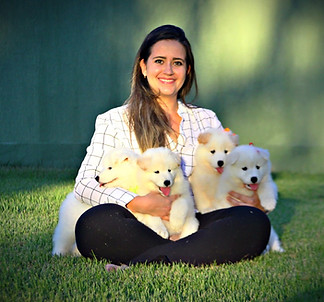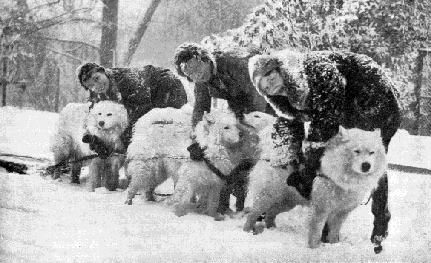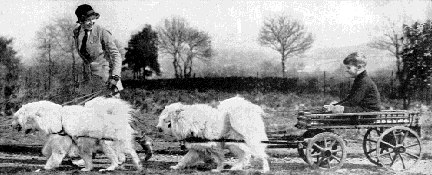

adopted a
Sammy
and is with
a thousand doubts?!
Thinking about adopting a Samoyed?
Below we have gathered some basic information to help you care for a baby Samoyed, including specific aspects of breed, hygiene and feeding!

The puppy's choice
the decision to choosing a puppy is very important. First of all, you need to be aware that, in addition to the arrival of a dog, many changes in your life will come with it.
Happiness, joy and companionship are all part of the package. But above all, know that a puppy is a living being , innocent, that will depend solely on you! He doesn't know how to buy food and doesn't know where to relieve himself. He will need your attention, care and, above all, your love!
Samoyeds have an average lifespan of 13 years. Before choosing a sammy to be a part of your days, imagine your life in the future for a decade and ponder if you will be available to take care of a puppy. Weighing all the pros and cons, it's time to decide!
A little about the race
The Samoyeds originate in northern Russia and Siberia. As a working dog, they were originally used by prehistoric Samoyed tribes - Bjelkier - (from which the name of the breed originated) to hunt, herding reindeer and pulling sleds, in addition to protecting them from the cold, putting the children to sleep with the dogs.


 |
|---|
 |
 |
 |
 |
 |
 |
 |
 |
The history of the breed is very old. Due to its geographic isolation, the Samoyed race is primitive and one of the purest races, along with three other races (Siberian Husky, Alaskan Malamute and Chow Chow), descends directly from the Gray Wolf , with no miscegenation of the race with another type. of wolf, fox or primitive dog breed. Its origin comes from the prehistoric era! More than 5000 years without human intervention.
Despite the fact that in some Samoyede tribes, which were focused In reindeer culture, Bjelkiers were easy raw material for food and clothing, earning a special place in the culture and in the rooms of the Samoyeds people. Inside the houses the Samoyeds had complete freedom of movement, because he was kind and friendly. He was a nanny for the children and they slept with the humans to protect them from the cold. And when it was needed, a group of several Bjelkiers could scare even one Polar Bear.

In the 18th to early 20th centuries, Samoyeds were brought to Europe as gifts to royalty, and to America, I return of polar expeditions, being intensified its traction work for this purpose.
In the 1980s, the Scott family imported some samoyeds and standardized the current color of the samoyed, which was not just ice white as we see nowadays. There were black or dark-spotted Samoyeds, as you can see in the images below:

'Ernest Kilburn Scott and Sabarka. Photograph taken about 1893

Roald Engelbregt Gravning Amundsen. Polar expedition on 10.20.1919
Read more...
Rex is probably the most famous dog you've never heard of. Rex of White Way was a canine Samoyed superhero known for over 30 mountain rescues throughout his life, including an impressive effort delivering a Truckee doctor to a snow train west of Donner Pass in January 1952. His exceptional stamina and uncanny ability to advance His tempestuous missions, despite dribbling and blinding snow, earned him the moniker - Rex, "The Blizzard King". Initially, it didn't look like Rex had an exceptional life. A few months later he was born in Sacramento, California, White Way Kennels in 1946, owners Agnes Mason and daughter Aljean took one look at the puppy and found that it could not be a candidate for the champion breeding program. By contemporary breeding standards, Rex was too tall, his thick coat too short, and his legs too long. Agnes almost found Rex an embarrassment to her well-respected kennel, but over time he became the best man of all American-born Samoys through his breeding and descendants. During the course of his life, Rex excelled in many ways. in which he became famous and the "new standard" for the breed. The height standard for male samoys has been increased by 1.5 inches, and now, 54 years after his death in 1957, the vast majority of samoyas in the United States can be genetically traced back to Rex of White Way. Rex is leading the Agnes Mason Sled Team, pictured:

Only in 1959, after several and important creational works around the world [which it was not possible to detail in this place due to its complexity], the Fédération Cynologique Internacional - FCI , entity to which we are affiliated, published a valid official standard, even others countries already have their own standard or the English standard.
Some features of your sammy!
How big should he grow? What's the temperament? Do I need to run with him every day? And the colors? Did mine come with brown spots? And now?

How big will it grow?
The Samoyed race, as already mentioned, has an official published standard, which guides how they should be the physical and behavioral characteristics of our so beautiful samoyed, from height, temperament, coat, etc. Here, we will try to succinctly show all the characteristics that a Samoyed must contain.
Average height at withers:

Female:
in 50 to 56 cm
Males :
from 54 to 60 cm
And the weight?

Height at the WITHERS, which is the prominent part of the scapula (shoulder blade or shoulder) of the quadruped. Corresponds to the point where the neck meets the upper line of the torso. Region between the neck and the back. This is where the dog's height is measured. ( Source )

Female:
in 16 to 25 kg
Males :
from 20 to 30 kg
Despite not having a standard, Samoyeds are medium to large dogs, with varying weights:
Did you know that there is not only white Samoyed?
Many people are startled when they see Samoyeds that are not entirely white. But is this possible?
To understand this, let's remember that the Samoyed tribes did not prefer white to their dogs. There were even Samoyeds that were completely black or with black spots. Only around 1890, with the beginning of creational work on the breed (breeders), especially by the Scott family, was there a selection and establishment of the predominance of white and the extinction of black in the breed standard.

'Pedro, owned by Mrs Cammack' (source)

'Young samoyeds by Peter The Great ex Alaska. Bred by the Hon Mrs McLaren Morrison.' (source)

'Sabarka, the original import brought to England by Mr Kilburn Scott in 1889. His color was described as 'deep biscuit'' (source)
In the establishment of the official Samoyed breed standard by the FCI, which is in force today, the official colors of the Samoyed are:

1) White
2) White and biscuit
3) Cream

White

white and cookie

Cream
Thus, in the official FCI standard, three are the colors of the Samoyed, with white predominating as the most popular color.


Even after a century of creation work by great creators around the world, sometimes the genes responsible for the black color surprise us with their appearance. In the photo, a Colombian puppy with a black spot.
And your temper?
Beautiful, wonderful, independent, friendly and, above all, affectionate, they are loyal and companions to their owner. In addition to the glamor and charm of her husband, with a penetrating, honest and proud look, she draws attention and captivates everyone with her unique and special smile.

Samoyeds, as working dogs, have courage, strength, endurance, persistence. and intelligence mainly. They have hunting and protection instincts, but, due to their great sociability, they are not successful in guard.
At people of the Samoyed tribes they lived in tents and huddled in the heat with their dogs on brutal arctic nights. This unusual degree of closeness of dog and master created a strong bond between Sammies and humanity.
I can say with certainty that they know how to communicate and literally talk to their owner. They are decisive and fight for what they want. The relationship with its owner will be extremely close and he will be a true friend and companion.
A Samoyed sentenced to solitary confinement in the yard/kennel is a miserable and destructive creature. These are smart dogs and too social that require love and attention, and should not be raised isolated and in small spaces. Believe me, he will make you pay attention to him. Don't forget, they are lovers of freedom and fun! Please don't forget any open gates, they might run away or someone will want to take them.
Read more...
Like most arctic dogs, it gets along very well with humans. Extremely affectionate, he loves to follow his owners everywhere and demands affection when people forget to pet him. Very gentle, the Samoyed is not suspicious of strangers and generally accepts being petted. Always attached to its owners, it can follow them anywhere without disturbing them, as long as it has been used to it since childhood. Its very clean nature and the completely neutral smell of its coat are advantages for indoor living. Another quality of the Samoyed is its cheerful, mischievous and very playful character, which makes it an excellent playmate for children. They rave about your cuteness, your teddy bear look and your lively temperament. He is able to spend an enormous amount of time playing ball, running and playfully fighting with them, without ever being aggressive. Incidentally, the game is an excellent way to facilitate the education of young Samoyeds, who do not like rigorous training. In fact, in this aspect it is advisable to progress slowly, in stages, as your personality is very complex. It is divided between a very strong primitive atavism (acute sense of hierarchy, submission to a real boss, etc.) and an almost cat-like side, proud, never servile, sometimes rebellious (characteristic of almost all Nordic dogs). This dualism demands from its owner a fine psychology and a good pedagogical sense, because if on the one hand it must make clear its dominance as a "pack leader", on the other it must be subtle enough to earn the Samoyed's obedience without hurting its pride. . The educator should try to maintain the puppy's trust and submission, which will be helped by the Samoyed's highly developed affection. You can use caresses, for example, to effusively reward the student. Softness and patience usually give better results than brutality, but this must also be dosed, so that the dog does not abuse the owner's goodwill. It is almost inevitable to see the moment arrive when the animal, already an adult, tries to evade the authority of the owner. If he succeeds, he will lose his place as “pack leader” and also his influence over the dog.
They are stubborn, independent, very intelligent, libertarian and playful. Hence, they need a very firm and loving hand in their upbringing . As a sled dog, it will tend to be dominant and will not hesitate to get into a fight with another dominant dog. Always be the leader of your pack!

Samoyeds are unique, special, different from all other dog breeds. Having a tutor who understands you and provides for your needs, both of you will know how to live in harmony and in complete happiness. and companionship. Their bond will transcend the mere human-dog relationship.
Whoever has a Samoyed is more than special!
Ready! I already chose my puppy! And now?
the first care
Vaccination
First of all, remember that a baby Samoyed is a living being and the first months of its life are at risk, and its new owner must strictly follow all veterinary prescriptions, notably the vaccination and deworming schedule.

Despite being a rustic, primitive dog with strong resistance, it is equally vulnerable to infections and fatal viruses common to all dogs. It is imperative that you be vaccinated up to date and not be exposed prematurely to public life. Commonly, up to 45 days of life, the puppy is immunized by the mother's breastfeeding. However, in our puppies we started the vaccination schedule at 30 days of age and followed a 21-day cycle with imported vaccine (V10).

Mandatory vaccines:
- V8 or V10
- Rage
Understanding vaccines:
-
V8 and V10: The difference between one and the other is simple. There are 4 types of Leptospirosis, for each type there is a specific antigen. Both protect the pet against 7 diseases, but V8 protects against Leptospira Canicola and Leptospira Icterohahemorrhagiae, while V10 includes the antigens for Leptospira Grippotyphosa and Leptospira Pomona. ³
-
Rage: The rabies vaccine is intended to prevent the dog from immunizing against the canine rabies virus. Canine rabies is a fatal virus that can be transmitted to humans. It has a high mortality rate. This virus is transmitted through the bites and scratches of already infected mammals .
-
Kennel Cough: It is indicated for the vaccination of healthy dogs, for the prevention of canine infectious tracheobronchitis, kennel cough, caused by the Parainfluenza virus and the B. bronchiseptica. Also known as Infectious Canine Tracheobronchitis or Tracheitis, Kennel Cough is one of the most common diseases among dogs. By triggering endless sessions of coughing and sneezing in infected dogs, the complication becomes even more contagious, since, through these symptoms, its spread is facilitated, with the air as a conduit for the disease.
Read more...
Distemper : It affects puppies up to one year of age. It is systemic, that is, it can affect several organs. The disease is viral and can be passed from one animal to another that is not immunized. The symptoms are: loss of appetite, eye and nasal discharge, diarrhea, vomiting, convulsions and death.
Canine infectious hepatitis: It is transmitted to the dog through secretions, droppings and blood infected by the adenovirus. Symptoms are fever, abdominal pain, vomiting, seizures, depression and coma.
adenovirus: It affects the respiratory system, opening the door for other more serious diseases to enter.
Coronavirus: It is found in the feces of infected animals. Symptoms are bouts of vomiting and diarrhea, fever, bloody stools, depression, loss of appetite and dehydration. It can lead the animal to death.
Parvovirus : One of the most lethal diseases in puppies. It is transmitted through the air or from the feces of an infected animal with a healthy one. Sudden death can occur in apparently healthy puppies.
Canine leptospirosis: It is a zoonosis, that is, transmitted from pet to owner. The contagion is through the urine of rats and the symptoms are discouragement, vomiting and hemorrhages. It can progress to chronic cases and lead the animal to death.
deworming
The control of parasites, especially intestinal parasites, is one of the most important care for the health of the baby Samoyed. Dogs that are not wormed regularly are at risk of getting sick and, depending on the severity of the infestation, they can die very quickly.
keep the dog free of parasites is to guarantee, in addition to the dog's well-being, the health of the family, a since some of these parasites are contagious to humans. Thus, it is essential to keep the dog's deworming up to date. A good dewormer and proper hygiene work together to ward off parasites and worms.
In our puppies, we start the deworming schedule at 15 days of age and reinforce fortnightly up to 70 days, always using the best wormers possible.
Next, we suggest to new tutors a deworming program for their sammy. Try to strictly follow this program!

ATTENTION to the substance called IVERMECTIN , found in many wormers. There are reports of substance toxicity in some Samoyeds. Therefore, if there is a dewormer with ivermectin in its composition, inform your veterinarian about its possible toxicity to sammy and, if you administer it, keep the dog under observation.

When taking a puppy home, regardless of the breed, many doubts will surely arise. Naturally normal!
When our puppies go to their new families, our goal is to ensure, first, the responsible ownership of the pup and, secondly, its well-being. They are completely innocent, vulnerable and dependent on their owner. Thus, we always pass on a lot of information to help in this new and most important phase of the puppy. Any wrong action can have its effects reflected in the dog's adult life and we want it to suffer as little as possible during adaptation.
For this we have gathered some basic information about the health, feeding and hygiene of the baby Samoyed. Read!
-
Giardiasis: For vaccination of healthy dogs from 8 weeks of age, as an aid in the prevention of clinical disease caused by Giardia lamblia, that sticks to the wall of the small intestine causing diarrhea and abdominal discomfort. It is a disease that can be transmitted to humans (zoonosis). She can bring bloody stools and diarrhea. The dog is easily infected by ingesting Giardia cysts, which can be present in water, food or animal hair. Giardiasis causes malabsorption/maldigestion syndrome, leading to dehydration, diarrhea, weight loss, abdominal pain, and flatulence.







